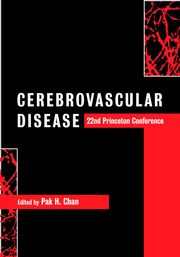Book contents
- Frontmatter
- Contents
- List of contributors
- Preface
- Acknowledgments
- Part I Special lectures
- Part II Oxidative stress
- Part III Apoptosis
- Part IV Hot topics
- 10 Astrocytes in ischemic stroke
- 11 Aquaporin-4 water channels and brain edema
- 12 Neuroprotection with tetracyclines in brain ischemia models
- 13 Spreading depression: a teleological means for self-protection from brain ischemia
- Part V Hemorrhage, edema and secondary injury
- Part VI Inflammation
- Part VII Gene transfer and therapy
- Part VIII Neurogenesis and plasticity
- Part IX Magnetic resonance imaging in clinical stroke
- Part X Risk factors, clinical trials and new therapeutic horizons
- Index
- Plate section
10 - Astrocytes in ischemic stroke
from Part IV - Hot topics
Published online by Cambridge University Press: 02 November 2009
- Frontmatter
- Contents
- List of contributors
- Preface
- Acknowledgments
- Part I Special lectures
- Part II Oxidative stress
- Part III Apoptosis
- Part IV Hot topics
- 10 Astrocytes in ischemic stroke
- 11 Aquaporin-4 water channels and brain edema
- 12 Neuroprotection with tetracyclines in brain ischemia models
- 13 Spreading depression: a teleological means for self-protection from brain ischemia
- Part V Hemorrhage, edema and secondary injury
- Part VI Inflammation
- Part VII Gene transfer and therapy
- Part VIII Neurogenesis and plasticity
- Part IX Magnetic resonance imaging in clinical stroke
- Part X Risk factors, clinical trials and new therapeutic horizons
- Index
- Plate section
Summary
Astrocytes are active participants in brain function
Astrocytes are electrically unexcitable cells that traditionally are regarded as the brain's support cells. A chief function of astrocytes is to maintain an optimal environment for synaptic transmission by tightly regulating interstitial ion and neurotransmitter concentrations. Other functions include production of neurotrophins and cytokines, and astrocytic endfeet are an essential part of the blood–brain barrier. In development, radial glial cells direct and support the migration of immature neurons. Several lines of work within the last few years have shown that astrocytes also participate more directly in neurotransmission. Astrocytes communicate with one another by calcium signaling and these calcium signals are transmitted to neurons. As such, astrocytes contribute to synaptic transmission. Recent reports have gone on to demonstrate that astrocytes are potent modulators of inhibitory transmission in the hippocampus and function as a necessary intermediary in long-term potentiation of GABAergic synapses (GABA is γ-aminobutyric acid).
Astrocytes have traditionally received little attention in the stroke field
Stroke research has paid little attention to astrocytes. During the last decade, the excitotoxin hypothesis has dominated the field. Since astrocytes are not sensitive to glutamate and survive exposure to 10 mM glutamate, it is not surprising that astrocytes have been regarded as minor players in the process of ischemic infarction. Also, astrocytes are highly resistant to ischemic conditions, whereas the viability of neurons is compromised within minutes.
- Type
- Chapter
- Information
- Cerebrovascular Disease22nd Princeton Conference, pp. 113 - 124Publisher: Cambridge University PressPrint publication year: 2002
- 1
- Cited by



